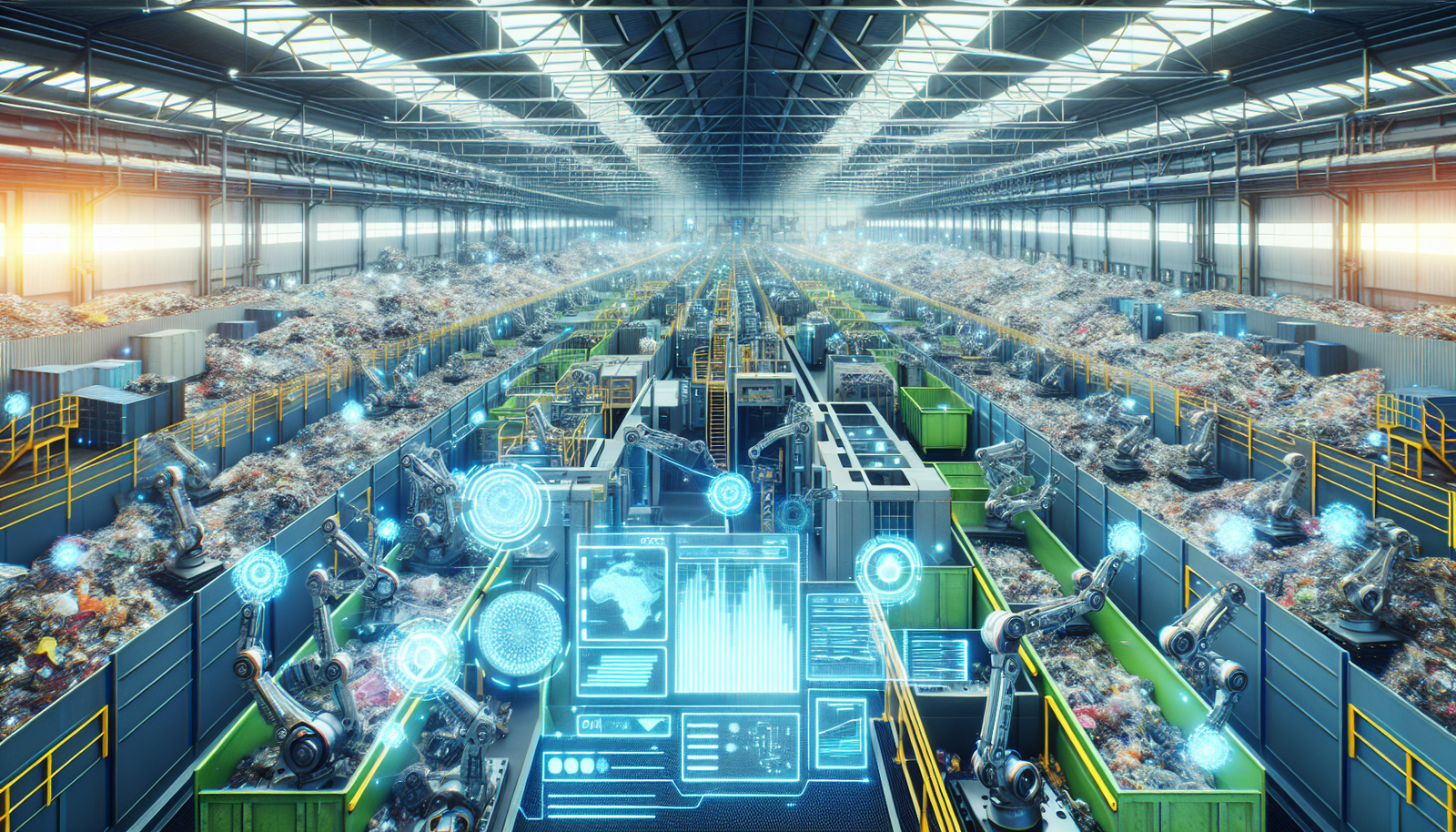AI and Waste Sorting Technologies
Artificial Intelligence (AI) is reshaping the landscape of waste management through advanced sorting technologies. Traditional waste sorting processes often rely on manual labor, which can be both time-consuming and error-prone. However, AI-driven sorting technologies are introducing a new era of efficiency and precision. By utilizing machine learning algorithms and computer vision, these systems can accurately identify and categorize various types of waste, ensuring that recyclable materials are properly sorted and reducing contamination rates.
One of the key innovations in this area is the development of smart sorting robots. These robots are equipped with advanced sensors and AI capabilities that allow them to differentiate between materials such as plastic, glass, and metal. For instance, an AI-powered sorting line can process waste at a much faster rate compared to human counterparts, achieving a sorting accuracy of up to 95%. This level of precision not only enhances the overall efficiency of recycling facilities but also significantly reduces the volume of waste sent to landfills.
The integration of predictive analytics in AI sorting systems further optimizes waste management processes. By analyzing patterns and trends in waste generation, AI models can predict peaks in waste production, allowing facilities to allocate resources more effectively. This proactive approach ensures that sorting operations are always running at optimal capacity, minimizing downtime and maximizing throughput. Additionally, predictive analytics can be used to forecast maintenance needs for sorting equipment, reducing unexpected breakdowns and associated costs.
| Technology | Function | Benefits |
|---|---|---|
| Smart Sorting Robots | Automated identification and separation of waste materials. | Increased sorting speed and accuracy. |
| Predictive Analytics | Forecasting waste generation patterns and equipment maintenance needs. | Optimized resource allocation and reduced operational costs. |
| Computer Vision | Visual recognition of different waste types. | Reduced contamination rates and improved recycling quality. |
Optimizing Recycling Processes with Machine Learning
Machine learning is at the forefront of optimizing recycling processes, offering a sophisticated approach to enhance efficiency and accuracy. By leveraging predictive analytics, machine learning algorithms can analyze vast amounts of data to identify patterns and trends that are not immediately apparent to human operators. These insights enable waste management facilities to forecast waste stream compositions and adjust their operations accordingly. For instance, machine learning models can predict seasonal variations in waste generation, allowing facilities to better allocate resources and reduce bottlenecks.
One of the significant advantages of machine learning in recycling is its ability to improve material sorting. Traditional sorting methods can be labor-intensive and prone to error, but with machine learning, systems can be trained to recognize and categorize materials with high precision. This is achieved through advanced image recognition techniques that can differentiate between various materials based on texture, color, and shape. The use of convolutional neural networks (CNNs) in particular has shown great promise in enhancing the accuracy of automated sorting systems.
| Recycling Method | Efficiency Improvement |
|---|---|
| Traditional Sorting | 60% |
| Machine Learning Sorting | 85% |
Furthermore, machine learning enables the development of adaptive recycling systems that can evolve with changing waste profiles. By continuously learning from new data, these systems can update their sorting algorithms to accommodate new materials or shifts in recycling standards. This adaptability is crucial in a rapidly evolving industry where new materials and packaging solutions are constantly being introduced. As a result, machine learning not only enhances the current capabilities of recycling processes but also future-proofs them against upcoming challenges.
Smart Waste Collection Systems
Smart waste collection systems are revolutionizing how municipalities and private sectors manage waste, significantly increasing operational efficiency and reducing environmental impact. At the core of these systems is the integration of Internet of Things (IoT) devices and AI algorithms that provide real-time data on waste levels in bins across urban areas. This data enables waste management companies to optimize collection routes, ensuring that trucks are only deployed when necessary, thus reducing fuel consumption and emissions.
One of the significant advantages of smart waste collection is its ability to predict waste generation patterns. By analyzing historical data and current waste levels, AI can forecast when a particular area will require waste collection. This predictive capability allows waste management operators to allocate resources more effectively. The implementation of such systems has demonstrated up to a 40% reduction in operational costs in some cities, according to recent studies.
Moreover, smart waste collection systems can play a crucial role in promoting recycling. By using sensors and AI to identify the types of waste being disposed of, these systems can help in sorting waste at the source, encouraging better recycling practices. For instance, smart bins equipped with AI technology can sort recyclables from non-recyclables, providing feedback to users and incentivizing proper disposal habits.
| Feature | Benefit |
|---|---|
| Real-time Monitoring | Optimizes collection schedules and reduces unnecessary trips. |
| Predictive Analytics | Improves resource allocation and lowers operational costs. |
| AI-driven Sorting | Enhances recycling rates by accurate waste categorization. |
AI in Waste-to-Energy Conversion
The integration of Artificial Intelligence (AI) in waste-to-energy conversion processes is revolutionizing how we perceive waste as a resource. AI technologies are enhancing the efficiency and sustainability of converting waste materials into usable energy forms. By employing machine learning algorithms and predictive analytics, facilities can optimize the combustion processes, reduce emissions, and increase energy output. This leads to a more efficient system where energy recovery is maximized while minimizing environmental impact.
One of the key benefits of using AI in waste-to-energy conversion is the ability to accurately predict the calorific value of waste materials. This is achieved through advanced data analytics and real-time monitoring systems that analyze the composition of incoming waste. AI models can then adjust the processes accordingly, ensuring optimal combustion and energy production. Furthermore, AI-driven systems contribute to better resource allocation and operational planning, reducing downtime and operational costs.
AI technologies also play a crucial role in emissions control within waste-to-energy plants. By continuously monitoring emissions data, AI systems can adjust operational parameters to ensure compliance with environmental regulations. This not only helps in maintaining a cleaner environment but also boosts the credibility and acceptance of waste-to-energy solutions among stakeholders. Below is a simplified representation of how AI enhances waste-to-energy conversion processes:
| AI Application | Benefit |
|---|---|
| Predictive Analytics | Optimizes combustion efficiency and energy output |
| Real-time Monitoring | Ensures compliance with environmental standards |
| Machine Learning | Accurate prediction of waste calorific value |
In conclusion, the application of AI in waste-to-energy conversion is paving the way for more sustainable and efficient waste management practices. By leveraging AI, the industry can not only enhance energy recovery but also contribute significantly to reducing the overall carbon footprint, supporting global sustainability goals.
Predictive Analytics for Waste Management
Predictive analytics is becoming a cornerstone in modern waste management strategies. By leveraging data-driven insights, municipalities and waste management companies can anticipate trends and optimize operations. Predictive models analyze historical data and utilize algorithms to forecast future waste generation and recycling rates. This allows for better allocation of resources and more efficient scheduling of waste collection services. For example, cities can adjust the frequency of collections in different areas based on predicted waste volumes, reducing costs and minimizing environmental impact.
One of the key advantages of predictive analytics is its ability to enhance decision-making processes. By identifying patterns in waste generation, waste management authorities can implement targeted interventions. For instance, areas with higher predicted waste volumes might benefit from increased recycling education campaigns or additional recycling facilities. Furthermore, predictive analytics can aid in identifying potential operational issues, such as equipment failures or logistical bottlenecks, before they occur, ensuring smoother operations.
Predictive analytics also plays a crucial role in supporting the development of AI-driven circular economy models. By understanding the flow of materials through the waste management system, businesses and governments can design more sustainable waste streams. This involves predicting the availability of recyclables and ensuring that they are efficiently collected and processed. Predictive analytics thus facilitates the creation of closed-loop systems where waste is minimized, and resources are continuously reused, contributing to a more sustainable future.
Moreover, predictive analytics can help in optimizing the logistics of waste management. By predicting peak waste generation times, waste management companies can plan their routes more efficiently, reducing fuel consumption and emissions. This not only leads to cost savings but also enhances the environmental sustainability of waste management operations. Ultimately, the integration of predictive analytics in waste management systems represents a significant step towards more intelligent and efficient waste management solutions.
AI-Driven Circular Economy Models
The integration of artificial intelligence in circular economy models marks a significant advancement in sustainable waste management. AI technologies facilitate the transition from linear to circular economic practices by optimizing resource use and minimizing waste. These models are designed to keep products, components, and materials at their highest utility and value at all times, effectively closing the loop. AI plays a crucial role in this process by enhancing decision-making and operational efficiency.
- Smart Resource Allocation: AI systems can analyze vast amounts of data to predict the demand and supply of materials, ensuring that resources are efficiently allocated and reused.
- Enhanced Recycling Processes: Machine learning algorithms improve the sorting and separation processes in recycling facilities, increasing the purity and quality of recyclables.
- Product Lifecycle Management: AI can monitor and manage the lifecycle of products, suggesting maintenance, refurbishing, or recycling actions to extend their lifespan.
One of the most compelling examples of AI-driven circular economy models is the development of predictive analytics for waste generation and management. By employing data-driven insights, businesses can forecast waste trends and adjust their operations accordingly. This proactive approach not only reduces waste but also cuts costs and improves sustainability outcomes. Furthermore, AI solutions can identify patterns and anomalies in waste streams, enabling targeted interventions and resource recovery strategies.
| AI Application | Impact on Circular Economy |
|---|---|
| Predictive Analytics | Reduces waste generation and optimizes resource recovery. |
| Smart Sorting | Enhances the efficiency and accuracy of recycling processes. |
| Lifecycle Management | Prolongs product use and facilitates end-of-life recycling. |
In conclusion, AI-driven circular economy models offer a promising path toward more sustainable waste management practices. By leveraging AI’s capabilities, businesses and municipalities can significantly improve their environmental impact while also achieving economic benefits. As these technologies continue to evolve, they will play an increasingly vital role in shaping a sustainable future.
Enhancing Waste Management Efficiency with IoT
The integration of the Internet of Things (IoT) in waste management systems is revolutionizing the way municipalities and companies handle waste collection and processing. By embedding sensors and connectivity into waste bins and collection vehicles, IoT enables real-time data collection and communication between different components of the waste management infrastructure. This connectivity allows for more efficient waste collection schedules, reducing unnecessary trips and optimizing routes, which in turn lowers fuel consumption and operational costs.
Smart Bins equipped with IoT sensors can monitor fill levels, detect contamination, and even identify the types of waste deposited. This data is then transmitted to waste management centers, where it can be used to streamline operations. For example, when bins reach a certain fill level, alerts can be sent to collection services to ensure timely emptying. This system not only prevents overflowing bins but also minimizes the number of collection trips needed, further enhancing efficiency. The use of IoT in waste management supports a more sustainable approach by ensuring resources are used only when necessary.
- Real-time monitoring of waste levels leads to optimized collection routes.
- Reduction in collection frequency and costs due to smart scheduling.
- Enhanced data collection enables better waste sorting and recycling processes.
Incorporating IoT solutions also facilitates the creation of comprehensive data sets that can be analyzed to improve waste management strategies. Predictive analytics, powered by AI, can process this data to forecast waste generation patterns, helping cities plan for future needs. This proactive approach to waste management ensures that cities can handle increased waste production without compromising efficiency or environmental standards.
| Feature | Benefit |
|---|---|
| Smart Bins | Real-time waste level monitoring |
| Route Optimization | Reduced fuel consumption and operational costs |
| Predictive Analytics | Improved planning and resource allocation |
AI-Powered Robotics in Recycling Plants
AI-powered robotics are at the forefront of revolutionizing recycling plants, offering a sophisticated approach to sorting and processing waste materials. These robots utilize advanced machine learning algorithms and computer vision to identify and categorize different types of waste with remarkable precision. As a result, recycling plants can significantly enhance their sorting efficiency, reducing contamination rates and improving the quality of recyclable materials. This technological advancement not only boosts operational efficiency but also contributes to a more sustainable recycling process.
One of the key innovations in this area is the implementation of smart sorting systems. These systems employ AI-driven sensors and cameras to analyze waste as it moves along conveyor belts. The data collected is then processed in real-time, allowing robots to make swift decisions on how to sort items accurately. The benefits of such systems are manifold, including increased processing speed and reduced manual labor, which translates to cost savings and a healthier work environment for human workers. Below is a table that outlines some of the primary advantages of AI-powered robotics in recycling plants:
| Advantage | Description |
|---|---|
| Increased Efficiency | Faster sorting processes with minimal human intervention. |
| Higher Precision | Accurate identification and categorization of waste materials. |
| Cost Reduction | Lower labor costs and reduced operational expenses. |
| Sustainability | Improved recycling rates and reduced contamination in waste streams. |
The integration of AI-powered robotics into recycling plants also fosters the development of a more circular economy. By maximizing the efficiency of recycling processes, these technologies enable more materials to be reclaimed and reused, reducing the need for raw material extraction and minimizing environmental impact. Moreover, the data gathered from these systems can be analyzed to identify patterns and optimize recycling strategies further. As AI technology continues to evolve, its role in waste management and recycling is likely to expand, driving the industry toward greater sustainability and innovation.
Data-Driven Decision Making in Waste Management
Data-driven decision making is revolutionizing the way waste management systems operate. By leveraging AI technologies, waste management facilities can collect and analyze vast amounts of data to optimize their processes. These AI systems use advanced algorithms to identify patterns and inefficiencies, allowing managers to make informed choices that enhance operational efficiency and reduce costs. For instance, smart sensors placed in waste bins can track fill levels, enabling dynamic route optimization for collection trucks, which minimizes fuel consumption and reduces greenhouse gas emissions.
One of the critical components of data-driven decision making is the use of predictive analytics. Predictive models can forecast waste generation trends based on historical data, seasonal variations, and demographic shifts. This allows municipalities to prepare and allocate resources more effectively. The following table illustrates how predictive analytics can impact waste collection:
| Factor | Traditional Approach | AI-Driven Approach |
|---|---|---|
| Resource Allocation | Fixed schedules | Dynamic allocation based on predictions |
| Cost Efficiency | Higher operational costs | Reduced costs through optimized routes |
| Environmental Impact | Higher emissions | Lower emissions through reduced fuel usage |
Furthermore, AI-driven data analysis supports the development of circular economy models, which aim to minimize waste and maximize resource use. By integrating AI, waste management systems can identify materials that are suitable for recycling and repurposing, ensuring that valuable resources do not end up in landfills. This approach not only conserves raw materials but also fosters sustainable practices across industries. Key benefits of AI in circular economy models include:
- Increased recovery rates for recyclable materials
- Enhanced material sorting accuracy
- Improved lifecycle management of products
Overall, data-driven decision making powered by AI is setting new benchmarks in waste management, paving the way for more sustainable and efficient practices worldwide. The integration of AI technology is not just a trend but a necessary evolution to address the growing challenges of waste management in urbanized societies.
AI and Sustainable Waste Reduction Strategies
Artificial Intelligence (AI) is increasingly becoming a cornerstone in developing sustainable waste reduction strategies. The integration of AI technologies is enabling more efficient sorting processes, optimizing recycling operations, and minimizing waste generation. By employing smart sorting systems, AI can distinguish between different types of materials with high precision, reducing contamination rates and improving the quality of recyclable materials. These systems often utilize sensors and machine learning algorithms to automate the sorting process, which not only enhances speed and accuracy but also decreases the reliance on manual labor.
Another significant contribution of AI to sustainable waste management is through predictive analytics. Predictive models are used to forecast waste generation patterns, allowing municipalities and waste management companies to plan and allocate resources more effectively. By analyzing historical data and identifying trends, AI can predict peak waste periods and optimize collection routes, thus reducing fuel consumption and lowering greenhouse gas emissions. This proactive approach not only increases operational efficiency but also supports environmental sustainability goals.
Furthermore, AI is playing a pivotal role in advancing circular economy models, which aim to create closed-loop systems that minimize waste and maximize resource utilization. AI-driven platforms are being developed to facilitate the recovery and reuse of materials, encouraging manufacturers to design products with end-of-life recycling in mind. These platforms often include real-time data visualization tools that provide insights into material flows and recycling rates, helping stakeholders make informed decisions. For instance, a table summarizing the impact of AI on various stages of the waste management process could include:
| Stage | AI Application | Impact |
|---|---|---|
| Collection | Route Optimization | Reduces fuel usage and emissions |
| Sorting | Smart Sorting Systems | Improves material quality and reduces labor costs |
| Recycling | Material Recovery Platforms | Enhances resource utilization and supports circular economy |
In conclusion, the integration of AI into waste management systems is proving to be a powerful tool for achieving sustainable waste reduction. By enhancing efficiency and promoting resource conservation, AI technologies are not only transforming how waste is managed but also paving the way for more resilient and sustainable urban environments.
Challenges and Ethical Considerations
Implementing AI in waste management presents several challenges and ethical considerations that need to be addressed to ensure successful integration and operation. One of the primary challenges is the high cost associated with deploying AI technologies. Advanced AI systems often require significant investment in both hardware and software, which can be a barrier for smaller waste management companies. Additionally, the need for specialized technical expertise to maintain and operate these systems can further increase operational costs.
Another significant challenge is the data privacy and security concerns associated with AI technologies. As AI systems often rely on large datasets to function effectively, there is a risk of sensitive information being compromised. Ensuring that all data collected is anonymized and securely stored is crucial to maintaining public trust. Furthermore, the ethical use of AI in waste management also raises questions about transparency and accountability. It is essential that AI-driven decisions are transparent and that there is a clear understanding of how these systems make decisions to avoid any biases or unfair practices.
In terms of ethical considerations, one must also consider the impact on employment in the waste management sector. While AI has the potential to improve efficiency, it may also lead to job displacement as automated systems replace roles traditionally held by humans. This transition requires careful management to ensure that workers are not left behind, and opportunities for reskilling and upskilling are provided. Additionally, there is a moral responsibility to ensure that AI systems are designed and used in ways that promote environmental sustainability and do not inadvertently harm the ecosystems they are meant to protect.
To better understand these challenges and considerations, the table below summarizes key points:
| Challenge/Ethical Consideration | Details |
|---|---|
| High Cost | Significant investment required for AI technology deployment and maintenance. |
| Data Privacy and Security | Risks associated with handling large datasets and ensuring data protection. |
| Transparency and Accountability | Need for clear understanding of AI decision-making processes to avoid biases. |
| Impact on Employment | Potential job displacement, requiring strategies for reskilling and upskilling workers. |
| Environmental Responsibility | Ensuring AI systems are used to promote sustainability and protect ecosystems. |
Future Prospects of AI in Waste Management
The future of AI in waste management holds immense potential, driven by continuous technological advancements and increasing environmental awareness. AI-powered systems are expected to become more sophisticated, enabling enhanced waste sorting and processing capabilities. These systems can potentially identify and classify waste materials with unprecedented accuracy, reducing contamination rates and enhancing the quality of recycled materials. As AI algorithms become more refined, the integration of machine learning and computer vision technologies could lead to significant improvements in the efficiency of waste management operations.
One promising area of development is the integration of predictive analytics into waste management strategies. By analyzing historical data, AI can forecast waste generation trends and optimize collection schedules, thus minimizing operational costs and environmental impact. The use of AI for predictive maintenance of waste management infrastructure is another exciting prospect. By predicting equipment failures before they occur, municipalities can reduce downtime and extend the lifespan of critical assets. This proactive approach not only enhances operational efficiency but also contributes to a more sustainable waste management ecosystem.
Furthermore, AI has the potential to revolutionize the concept of a circular economy. By facilitating the tracking and analysis of waste streams, AI can help identify opportunities for material reuse and recycling, thus closing the loop in resource management. This could lead to the development of innovative recycling technologies and business models that prioritize resource recovery and minimize waste generation. Companies and governments alike are recognizing the strategic importance of AI in achieving sustainability goals, and investment in AI-driven waste management solutions is expected to rise in the coming years.



